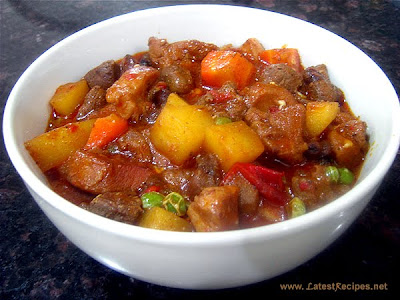by Rosalina Ocampo Tañedo
Caldereta (Kaldereta) is a popular dish in the Philippines. It is served hot as a main course. This hearty dish is a main staple on Barrio Fiestas, Weddings, Christening, and other large gathering events.
Ingredients:
- 1 kilo (2.2 lbs) beef shank or chuck cut into cubes
- 1 large red or green bell pepper cut into strips
- 1 large carrots cut into cubes
- 1 large potato cut into cubes
- 1 medium size onion - chopped
- 5 cloves garlic - minced or crushed
- 1 cup of peeled garbanzo beans
- 1 cup vinegar
- 1 cup soy sauce
- 1 cup water
- 1 10 ounces (284 G) tomato sauce
- 1 cup liver paté
- 3 tablespoons of cooking oil
- 3 laurel (bay leaves)
Directions:
- Mix beef with vinegar and soy sauce in a dutch pan and boil in medium heat until tender. Turn of heat and set aside.
- In a separate sauce pan, heat the 3 table spoons of cooking oil in low heat. Fry the potatoes and carrots in high heat until they are partially soft on the edges but not all the way cooked inside. Set aside.
- Using the same sauce pan, sauté the garlic and onion until garlic is golden brown.
- Add the tomato sauce and let simmer for 5 minutes.
- Add beef with vinegar and soy sauce marinade. Add Bay leaf. Raise heat to medium high and cover and let it simmer for 30 minutes.
- Add carrots and potatoes. Cover and let it simmer for 15 minutes.
- Add garbanzo beans, liver paté, and red bell. Cover and let it simmer for another 15 minutes in low heat.
- Serve with steamed white rice.
While pork and beef are the preferred meat to use for this dish, Pilipinos also use chicken, goat, duck, and lamb as alternatives. Cooking needs to be adjusted depending on the meat being used. Pilipinos like using the bony part of a cut since the marrow adds flavor to the dish and some people also add other garnishes such as olives and green peas.
Preparation time: 30 minutes
Cooking time: 1 1/2 hours
Makes 4 to 6 servings.
Food for thought:
| Translation of Keywords |
|---|
| | Spanish | English |
karne ng baka |
karneng baka |
carne de vacuno |
beef |
patatas |
patatas | patatas | potatoes |
sibuyas | sibuyas | cebolla | onion |
bawang | bawang | ajo | garlic |
siling pula | larang malutu | pimiento rojo | red bell pepper |
karot | karot | zanahorias | carrots |
kamatis | kamatis | salsa de tomate | tomato sauce |
tubig | danum | agua | water |
garbanso | garbanso | garbanzo | chick peas |
tasa | tasa | taza | cup |
kutsara | kutsara | cucharada | tablespoons |
| Other recipes You might like |
|---|
| |
 Kare Kare is a peanut-based stew with vegetables and meat. Beef and Pork are the most common meat used for this dish but Oxtail and sometimes Tripe are used or a combination of both. It is usually served with Bagoong - a salty condiment made of small alamang (shrimp)pickled in brine, sautéed with onions and garlic to enhance the flavor....see more
|  Chicken Adobo is a very simple dish to cook that most Pilipinos in all walks of life know how to cook it. Adobo is a Spanish word which means "sauce" or "marinade". It is cooked in many different ways. Bicolanos in the Bicol Region or Bicolandia known for their penchant use of coconut milk, this ingredient is also added which gives Adobo a rich flavor and a silky texture. Chili peppers are also used to give it an extra...see more
|
Tomato (Kamatis in Pilipino) (Solanum lycopersicum)

The tomato fruit is consumed in diverse ways, including raw, as an ingredient in many dishes and sauces, and in drinks. While it is botanically a fruit, it is considered a vegetable for culinary purposes (as well as by the United States Supreme Court, see Nix v. Hedden), which has caused some confusion. The fruit is rich in lycopene, which may have beneficial health effects.
The tomato belongs to the nightshade family. The plants typically grow to 1–3 metres (3–10 ft) in height and have a weak stem that often sprawls over the ground and vines over other plants. It is a perennial in its native habitat, although often grown outdoors in temperate climates as an annual. see more...







